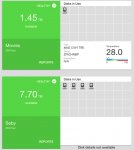Hi, first off, I'm new to all of this. I'm not a network guy at all. So please be gentle ;) .
Ok, I have already a FreeNAS setup as movies, photos, video, souvenirs for our family.
I have look to back up everything on cloud, but too complicated for me and don't have the money for it.
So I have an old laptop here that "maybe" I thought I could use to backup the FreeNAS once a week but off-site. So I have an external USB 10TB that could be plugged to it. So I could bring that laptop at my friend's house and wired to the internet to copy once a week my FreeNAS. Or actually, what is new.
Is this possible first?
If yes, could you help me on that?
tks
Seby
Ok, I have already a FreeNAS setup as movies, photos, video, souvenirs for our family.
I have look to back up everything on cloud, but too complicated for me and don't have the money for it.
So I have an old laptop here that "maybe" I thought I could use to backup the FreeNAS once a week but off-site. So I have an external USB 10TB that could be plugged to it. So I could bring that laptop at my friend's house and wired to the internet to copy once a week my FreeNAS. Or actually, what is new.
Is this possible first?
If yes, could you help me on that?
tks
Seby



